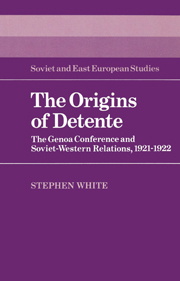Book contents
- Frontmatter
- Contents
- Preface
- List of abbreviations
- Technical note
- 1 Europe and Russia after the war
- 2 Approaching the Russian problem
- 3 From Cannes to Boulogne
- 4 Diplomatic preliminaries
- 5 Soviet Russia and Genoa
- 6 The conference opens
- 7 Rapallo
- 8 Closing stages
- 9 Genoa and after
- Notes
- Select bibliography
- Index
1 - Europe and Russia after the war
Published online by Cambridge University Press: 04 August 2010
- Frontmatter
- Contents
- Preface
- List of abbreviations
- Technical note
- 1 Europe and Russia after the war
- 2 Approaching the Russian problem
- 3 From Cannes to Boulogne
- 4 Diplomatic preliminaries
- 5 Soviet Russia and Genoa
- 6 The conference opens
- 7 Rapallo
- 8 Closing stages
- 9 Genoa and after
- Notes
- Select bibliography
- Index
Summary
The Genoa Conference of April–May 1922 was the twentieth in a series of inter-Allied gatherings which took piace after the end of the First World War and which has subsequently become known to historians as the period of ‘conference diplomacy’. The meetings generally took place in Mediterranean seaside resorts – the French prime minister, Raymond Poincaré, dubbed them ‘la politique des casinos’ – and they generally dealt with matters that the Versailles peace settlement had left unresolved, or in which subsequent complications had occurred. Gatherings of diplomats to rearrange the international system in this way had of course taken place before, most obviously during the Congress of Vienna and the ‘Congress system’ of 1815–22, and precedents could be found in the Treaty of Westphalia of 1648 and perhaps earlier. Traditional in its form, the Genoa Conference was at the same time a gathering whose proceedings had a distinctively modern tone. Its leading figures were politicians, rather than career diplomats, and its proceedings concerned the reconstruction of the European economy, rather than traditional matters such as the settlement of the terms of peace and the renegotiation of state boundaries. Above all, from the point of view of this study, it was the first conference at which political leaders from both East and West met together and attempted to resolve the nature of the relationship between them, a relationship which has lain at the centre of international politics from the October revolution of 1917 up to the present.
- Type
- Chapter
- Information
- The Origins of DetenteThe Genoa Conference and Soviet-Western Relations, 1921–1922, pp. 1 - 28Publisher: Cambridge University PressPrint publication year: 1985



